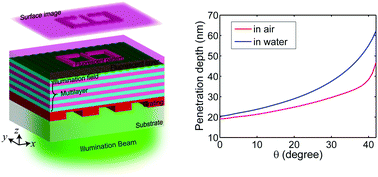Surface imaging microscopy with tunable penetration depth as short as 20 nm by employing hyperbolic metamaterials†
Abstract
Advancement in the understanding of biomolecular interactions has benefited from the development of surface imaging microscopy with high sensitivity and contrast. In this work, surface imaging microscopy with tunable penetration depth as short as 20 nm is proposed. By employing a hyperbolic metamaterial (HMM) composed of metal/dielectric multifilms, the deep subwavelength bulk plasmon polaritons (BPPs) are excited as the uniform and large area surface illumination source. Moreover, the penetration depth of the surface illumination structure could be continually tuned by changing the incidence angle of excitation light. In the experiments, a penetration depth of 25–38 nm in air is achieved at 532 nm by the HMM with Ag/SiO2 multilayers. Subsequently, a fluorescence pattern was imaged against another fluorescent background by this surface imaging microscopy, and the results indicate that distinct surface images with high contrast could indeed be obtained under BPP illumination with ultra-short penetration depth. This approach provides a promising avenue for tracking single-molecule and cell plasma membrane events.



 Please wait while we load your content...
Please wait while we load your content...